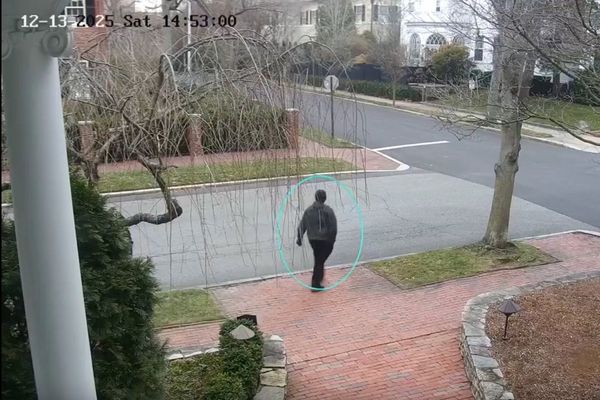Installing comprehensive home security doesn’t need to be as complicated or expensive as it sounds. Today’s smart home technology means security systems and house alarms can be wireless, easy to fit, and controlled from a smartphone, or even your voice.
There are several different companies to choose from, each offering its own range of security systems, which all vary in terms of price, scale and functionality. Some smaller systems work best for one-bedroom apartments, while others have enough components to secure an average home, and some can even be expanded into a vast system of 100 individual devices all working together to protect you and your property – garages, sheds and other outbuildings included.
Key companies to consider include Ring, Yale, TP-Link Tapo, Eufy and our current favourite alarm system, Simplisafe. But there are many others too, each offering devices like video doorbells, motion detectors, security cameras, door sensors, sirens, keypads and more.
Save 45% with our exclusive voucher code

You can save 45 per cent on a Simplisafe home security system with this discount code, exclusive to The Independent’s readers. Simplisafe kits range in size, depending on your needs and the size of your property.
All work with a central control hub and keypad, along with security cameras for the interior and exterior of your home, plus door/window sensors, motion detectors, leak sensors and more.
These alarm systems all work in a broadly similar way, with their individual sensors connecting wirelessly to a central control hub, which then connects to the internet via your router. The system is then controlled using a smartphone app.
But where they differ is when it comes to subscriptions and live monitoring. The latter is where a company employs staff who are alerted when your home alarm is triggered. They can then alert you, and check in on your home through the status of sensors and even via the security cameras, before calling the police or other emergency services if required. Some monitoring alarm services will also, included with the cost of their subscription, dispatch an agent to check on the home if the situation is unclear.
How we tested
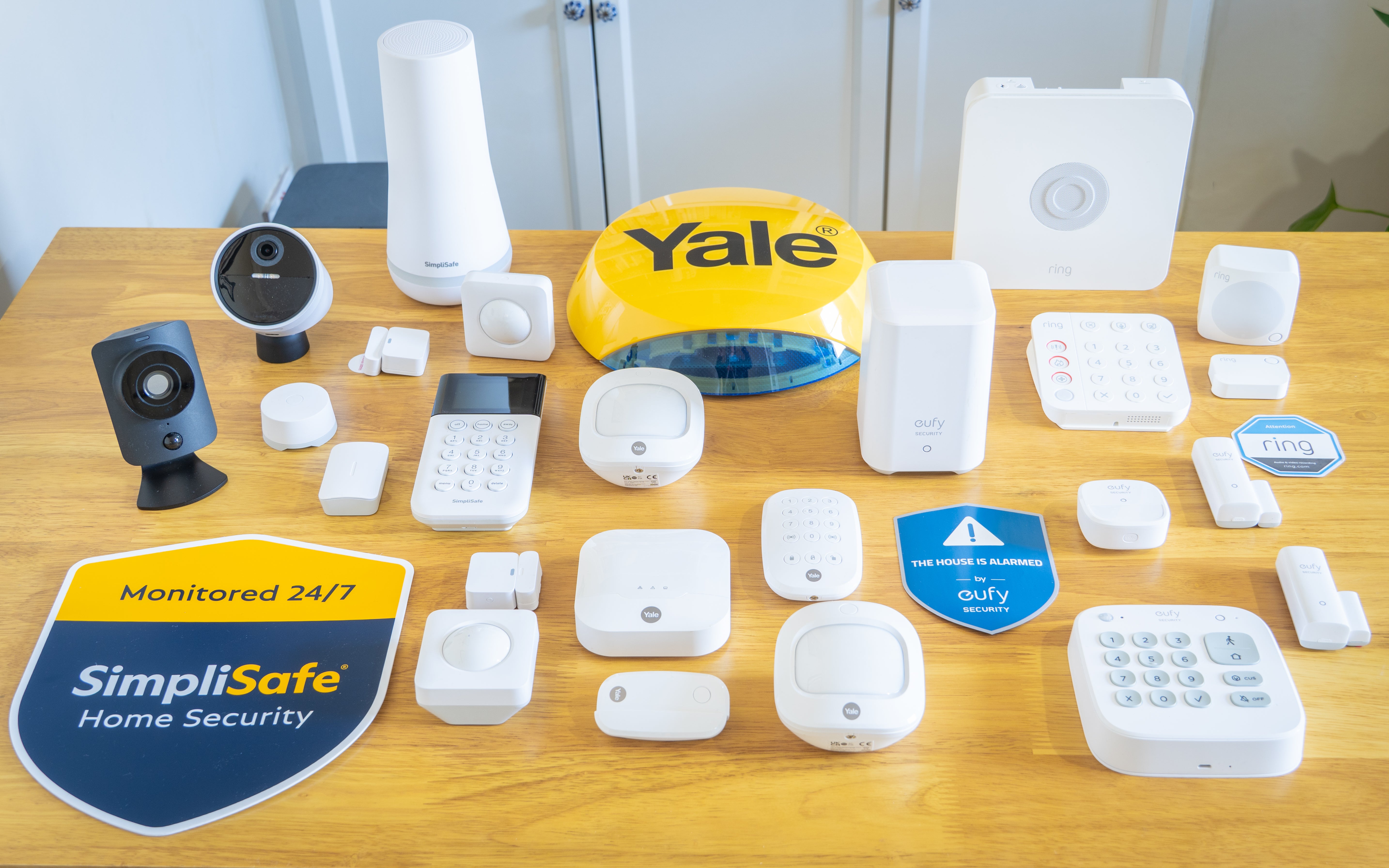
I installed and used each of the alarm systems featured below for at least a week. During that time, I assessed how smooth the installation process was, how well the companion smartphone application worked, and whether the hardware optionally connects to smart home platforms like Amazon Alexa, Apple HomeKit and Google Home.
With the installation complete, I used each alarm system as if it were my own. Fitted to the doors and windows of my home, I monitored how quickly they responded to entry and exit, and assessed the loudness of their sirens. I also paid close attention to how much configurability each offered, what other products could be added to expand the system and, of course, what their various subscription services offer.
I also tested how well the security systems work when away from home and, where available, how they interact with other smart home products, such as Philips Hue lighting.
Why you can trust us
The Independent is committed to providing unbiased reviews and expert shopping advice across a range of home improvement products. Our team of experts has spent years testing and rating the latest smart home tech in our homes, gardens and under real-world conditions, so you can be sure our verdicts are authentic and based on personal experience with each product featured. When it comes to security systems, our expert testers consider everything from app features and ease of setup to ongoing subscription costs.
The best home security systems for 2025 are:
- Best overall – Simplisafe: From £156.71, Simplisafe.com
- Best for cameras – Ring: From £219.99, Ring.com
- Best without a subscription – Eufy: From £159, Eufy.com
- Best for covering the basics – Yale Sync: From £269.99, Yale.com
- Best for smart home builders – TP-Link Tapo: From £159.99, Uk.store.tapo.com
Best home security systems at a glance:
System |
Professional monitoring |
Backup-up battery power |
Cellular backup |
Wifi connection |
Simplisafe |
Yes, with subscription |
Yes |
Yes, with subscription |
Yes, Ethernet optional |
Ring Alarm |
No, not in UK |
Yes |
Yes, with subscription |
No, Ethernet only |
Eufy Security |
No, not in UK |
No |
No |
No, Ethernet only |
TP-Link Tapo |
No |
No |
No |
Yes, plus Ethernet |
Yale Smart Alarm |
Yes, with subscription |
Yes |
Yes, with subscription | Yes, Ethernet optional |
Simplisafe
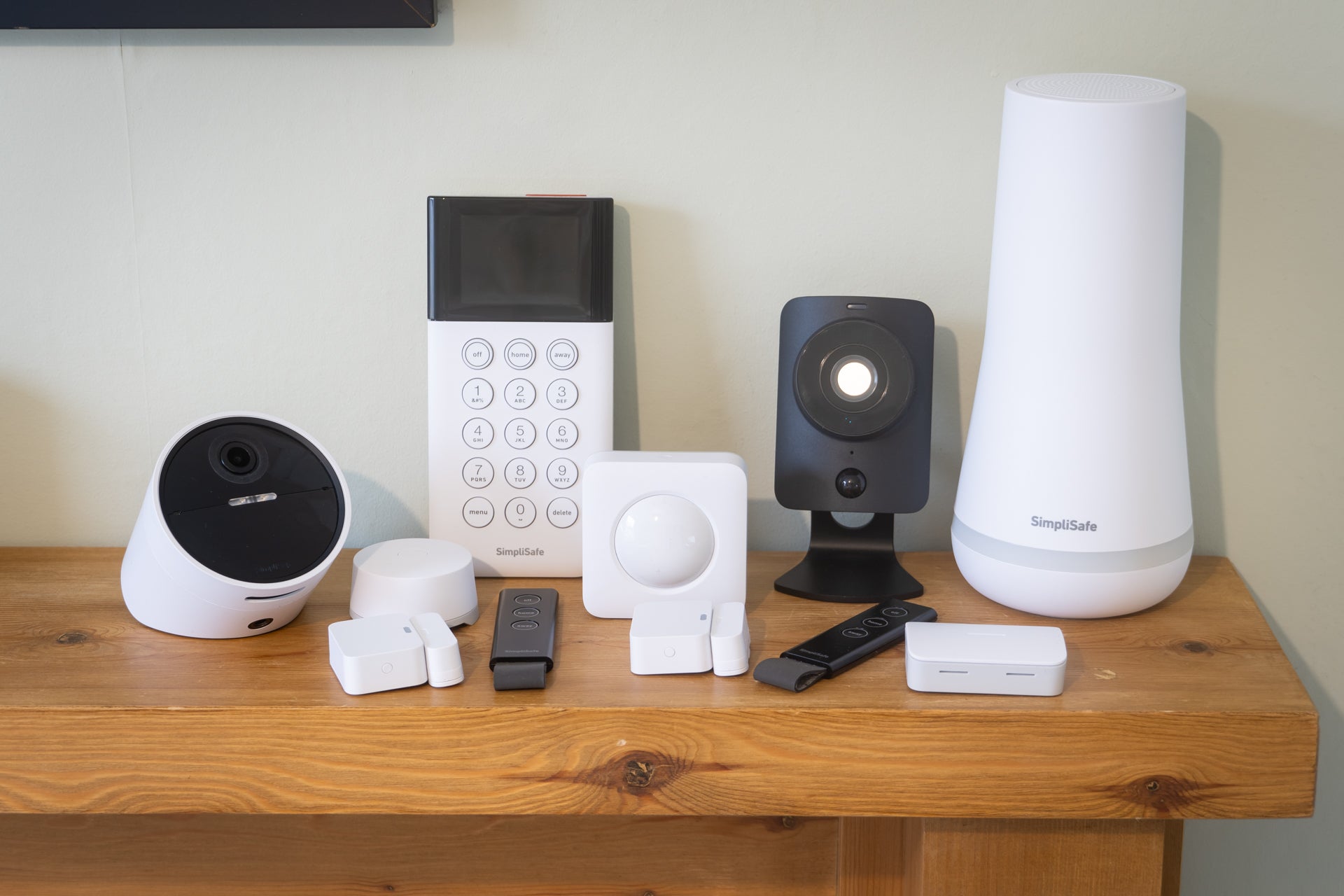
Best: Overall
Wifi: Yes, Ethernet optional
Cellular backup: Yes
Battery backup: Yes (24 hours)
Base station range: 150 metres
Sensor/accessory limit: 100
Base station dimensions: 21cm x 10.2cm x 10.2cm
Outdoor siren: No
Professional monitoring: Yes, subscription required
Why we love it
- Easy to set up
- Lots of accessories available
- Live monitoring with emergency response
Take note
- Some hardware feels dated
- Little functionality without subscription
- Outdoor camera not always reliable
As the name suggests, Simplisafe is a home security and alarm system that aims to put simplicity first. In a world where some security kits require a thorough understanding of how smart home systems and voice assistants work, this is a refreshing change.
The Simplisafe system has created a middle ground for itself, somewhere between the more complex offerings of Ring and Nest, while being smarter and more connected than older traditional home security systems. I can see this approach appealing to homeowners (and renters) who want a very simple setup process, and who want to avoid the extra functionality and inherent complexity of more feature-packed systems.
This can make the Simplisafe kit look and feel slightly dated, with the keypad especially resembling something from a decade or two ago. It doesn’t even have a colour display, let alone a touchscreen.
But, again, I can see the appeal here. It’s a product that looks part of a traditional home alarm system, but which is fully wireless, connected to the internet and (with the right subscription) includes professional monitoring and police response – something Ring does not offer in the UK. In this sense, despite offering an entirely DIY installation, Simplisafe is closer to the services of traditional alarm companies like ADT than tech-first systems like Ring.
Cameras
Simplisafe offers two different models of security camera, one for inside your home and one for outside, plus a video doorbell. Adding these to your security system is entirely optional, but all of Simplisafe’s kit bundles come with at least one camera.
These cameras are far simpler than many rivals, like those from Ring and Eufy. This is great news for buyers who want a plug-and-play security system that can be installed quickly and simply, but the cameras’ lack of features might leave other buyers wanting more. The indoor and outdoor cameras both record at 1080p Full HD, and both have a microphone and speaker for two-way audio, plus the indoor cameras has a physical lens cover for extra privacy when it isn’t in use.
Although lacking some features offered by rivals – like face recognition, parcel detection and solar power – the key to Simplisafe’s cameras is how they can be used to verify an emergency situation. If a burglar triggers your alarm, an agent (with your prior permission) can view a live feed from the camera, then inform the emergency services. The indoor camera comes with a power cable and the outdoor camera uses a rechargeable battery.
Monitoring
Constant professional monitoring is arguably the biggest and most valuable feature of the Simplisafe system. If the alarm is triggered, Simplisafe’s call centre is alerted. They then call you to check if the alarm is genuine, and can even use your security cameras (with your prior permission) to assess the situation and call the emergency services if required. If an incident cannot be verified over the phone or through your cameras, Simplisafe will dispatch an agent to visit your home.
Simplisafe will also get in touch with you (or call your emergency contacts if you don’t answer) when smoke is detected, or when your system’s water leak and high/low temperature sensors are triggered.
Subscription cost
Subscriptions start at £19.99 for Simplisafe’s Pro Standard plan. This is a self-monitored alarm system, where you’ll be alerted by the app if there’s a break-in, fire or water leak, and your emergency contacts will be phoned.
The next tier is called Pro Premium and costs £27.99 a month. This includes professional monitoring, as outlined in the previous section, where an agent phones you, establishes the severity of an incident (like a break-in or fire) and calls the emergency services.
Deals and discounts
As mentioned earlier, readers of The Independent currently have exclusive access to a 45 per cent discount using the button below.
Simplisafe is also running an early Black Friday deal, where all systems purchased with a Pro Premium Monitoring subscription have been reduced by 50 per cent – plus, Simplisafe is including a £100 Amazon gift card.
Read the full Simplisafe review
Buy now £160.00, Simplisafe.co.uk
Ring Alarm
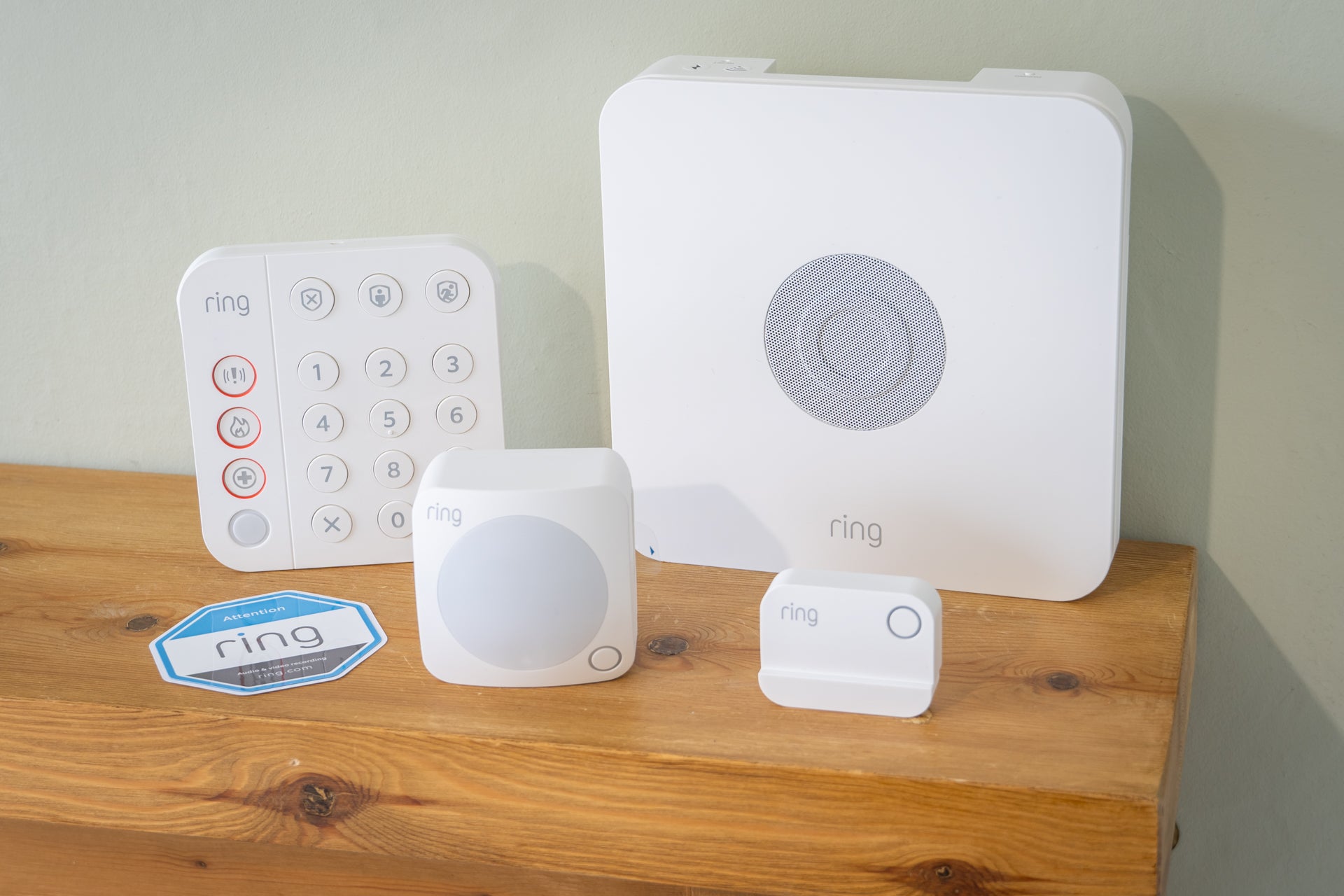
Best: For cameras
Wifi: No, Ethernet only
Cellular backup: Yes (subscription required)
Battery backup : Yes, 24 hours
Base station range: Up to 76m
Sensor/accessory limit: 100
Base station dimensions: 17cm x 17cm x 4cm
Outdoor siren: Sold separately
Professional monitoring: No (not in UK)
Why we love it
- Simple setup
- Great interaction with other Ring products
- Battery and cellular backup
Take note
- No live monitoring (in UK)
- Cannot call emergency services (in UK)
- Limited functionality without subscription
Ring is arguably the biggest name in smart home security, and for good reason. The Amazon-owned brand has built a solid reputation off the back of its video doorbells and security cameras, which we rate highly. But the company also sells a smart alarm system, which uses the same smartphone app and taps into the same subscription services available to owners of Ring doorbells and cameras.
In its simplest state, the alarm includes a base station with integrated sire, a wireless keypad, a motion detector and a door/window sensor. The system uses Z-Wave wireless technology and can be expanded to include up to 100 devices. There’s both battery and cellular backup, so the base station will keep working if your internet goes down, and can run off its own battery for up to 24 hours if there’s a power cut.
However, this cellular backup is one of the many features of this kit that requires a subscription. Prices start at £7.99 a month or £79.99 for a year, and without it the system loses much of its functionality. Pay up, and the Ring Alarm offers just about everything you could ever need, and it of course ties in neatly with Ring’s doorbells and security cameras. There’s also integration with the Amazon Alexa smart home platform and voice assistant.

Despite being available in the US, Ring does not offer professional monitoring in the UK. Instead, it operates a system called Alarm Calls where, if the alarm is triggered, your pre-defined list of emergency contacts will be called, one after another, until one answers. They are then given an automated message from Ring, stating that your alarm has been triggered, as well as what caused it (such as a door being opened, or motion spotted in the kitchen), and when. No human is involved in this, and there’s no direct way of calling the emergency services. That said, it works well and serves as a useful way of alerting your emergency contacts at times when you can’t see a notification on the Ring app, or your phone is switched off.
Although it lacks proper monitoring, Ring Alarm is still a great system – especially for anyone who already owns a Ring product, like one of its video doorbells. Adding this kit is the obvious next step for upping your home security game, and the extra functionality makes Ring’s subscription feel like better value for money than when it’s usually purely for a doorbell.
Cameras
Ring sells a wide range of security cameras, all of which work with the same app as the Ring Alarm system. Prices start at under £50 and run up to £200 for the more advanced models. Both indoor and outdoor cameras are available. Some work with optional solar powers for unlimited power, and some have integrated spotlights too.
The smartest models, like the Ring Outdoor Camera Pro, use radar and satellite imagery to accurately track the movement of visitors (or trespassers) across your garden or driveway. Some have colour night vision for more detailed low-light footage, and others can even save video from the moments before movement was first detected.
Cameras like the Ring Outdoor Camera Plus perform well, with 2K imaging sensors and long battery life, but none offer local video storage. Instead, to save video recordings in the cloud you must pay for a Ring subscription.
Monitoring
Despite being available in the US, Ring does not offer professional monitoring in the UK. Instead, it operates a system called Alarm Calls where, if the alarm is triggered, your pre-defined list of emergency contacts will be called, one after another, until one answers. They are then given an automated message from Ring, stating that your alarm has been triggered, as well as what caused it (such as a door being opened, or motion spotted in the kitchen), and when.
No human is involved in this, and there’s no direct way of calling the emergency services. That said, it works well and serves as a useful way of alerting your emergency contacts at times when you can’t see a notification on the Ring app, or your phone is switched off.
Subscription cost
Ring has two tiers of alarm subscription. The first is called Standard and costs £7.99 a month or £79.99 for a year. This adds cellular backup, so the alarm keeps working if your WiFi goes off, and enables cloud storage for your Ring video doorbell and security cameras too.
The Premium tier costs £15.99 a month or £159.99 a year and, while this doesn’t add any more features to the alarm system, it unlocks the option for 24/7 recording for your Ring cameras.
Deals and discounts
Since Ring is owned by Amazon, its products are frequently discounted by the retail giant. Plus, as is often the case with tech sales, when Amazon cuts its prices, everyone else does too – so it’s always worth checking out Ring products at retailers like Currys, Argos, AO, B&Q and others to check which has the biggest savings.
As of the most recent update to this article, these are the best Ring deals and discounts we’ve found:
Read the full Ring Alarm review
Buy now £219.00, Ring.com
Eufy Security home alarm kit

Best: Security without a subscription
Wifi: No, Ethernet only
Cellular backup: No
Battery backup: No
Base station range: 90 metres
Sensor/accessory limit: 50
Base station dimensions: 8.5cm x 13cm x 8.5cm
Outdoor siren: Sold separately
Professional monitoring: No
Why we love it
- Great value
- Easy to set up and configure
- Expandable with cameras, doorbells and more
Take note
- No battery or cellular backup
- Door/window contact sensors are quite large
- No professional monitoring in the UK
Eufy sells a wide range of tech products, from robotic vacuum cleaners and floor mops, to security cameras, video doorbells and alarm systems. We especially like how, unlike many of its rivals in the home security space, Eufy does not charge a subscription.
Its cameras record locally (either to their own storage or to storage within the base station) instead of uploading to a costly cloud server, and the alarm system works fully without any ongoing costs. While there is a subscription option available, this is only needed if you want cloud backup of your security camera footage.
The hardware looks and feels good, although the door/window contact sensors are on the large side, and the wireless keypad has a battery life of 180 days between charges. The base station can be plugged into your router with the included Ethernet cable, or connected wirelessly, but it lacks the cellular and battery back-up systems offered by rivals. This means if your power goes out or the internet drops out, your alarm system stops working.
That said, we think the kit represents great value for money, and we love how extras like security cameras can be added with ease and without an ongoing subscription fee. The company also sells useful accessories like solar panels to give your outdoor cameras unlimited power, plus floodlights.
Cameras
Eufy’s alarm system can be expected with a range of indoor and outdoor security cameras, priced from under £30. My favourite of these is the Eufy SoloCam S340, which is a wireless outdoor camera that has two lenses, motorised panning and tilting, and an included solar panel that constantly tops-up the battery.
Eufy’s security cameras can work independently, saving footage to a microSD card (and therefore not charging you a subscription for cloud storage). Or, they can connect to the Eufy HomeBase, which lives inside your home and acts as a central storage unit for multiple cameras. The HomeBase also acts as an alarm and unlocks new features for the cameras, like facial recognition, which uses AI to only record when the camera spots a stranger.
Monitoring
Eufy’s cameras offer more functionality than those of Simplisafe, but this system lacks any form of monitoring, professional or otherwise. You’ll be alerted via the phone app when the alarm is triggered, but there’s no option to have an automated call go out to your emergency contacts, as Ring does for UK subscribers. This is the compromise with Eufy’s no-subscription service; you get a system packed with useful features and configurability, with excellent cameras available too, but there’s no monitoring.
Subscription cost
While not strictly needed, Eufy offers a cloud storage service and prices start at £3.99 a month or £39.99 a year for one device (such as one security camera) and 30 days of storage. A pricier tier costs £12.99 a month or £129.99 a year and covers all of your Eufy security devices (cameras and doorbells), and also lets you access videos for 30 days after they are recorded.
Deals and discounts
Eufy has its own online store, which is often populated with deals and discounted bundles for both its security and cleaning products. There are often savings to be made when buying multiple Eufy security cameras at once, or for picking up a set of related products, like a camera, video doorbell and one of Eufy’s Homebase hubs. Naturally, these discounted prices are usually replicated by Amazon and other electronics retailers too.
Here’s what we’ve found recently:
Read the full Eufy Home Alarm review
Buy now £159.00, Eufy.com
TP-Link Tapo
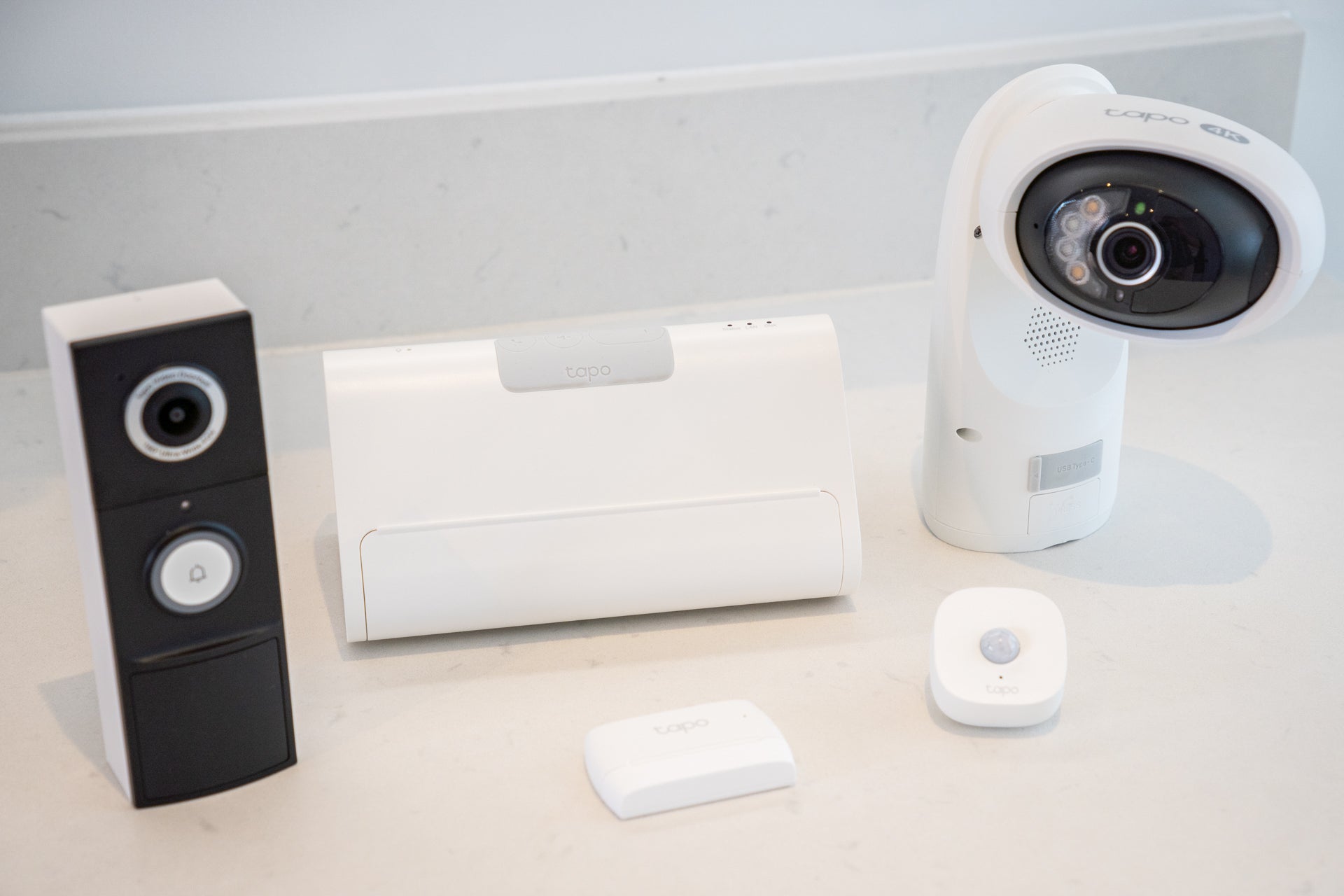
Best: For smart home builders
Wifi: Yes, 5GHz
Cellular backup: No
Battery backup: No
Base station range: Not stated
Sensor/accessory limit: 16 cameras and 64 sensors
Base station dimensions: 16 x 9.9 x 8.3 cm
Outdoor siren: No
Professional monitoring: No
Why we love it
- Good value
- Highly configurable
- H500 hub has Matter support
Take note
- No professional monitoring
- No keypad or external siren
- More complexity than some might want
TP-Link’s Tapo brand has made home security cameras and accessories for years now, plus smart lights, plugs and other devices too. But what qualified Tapo for this article was the new H500 hub, which arrived in the summer of 2025.
This acts as a central command centre for all of your Tapo devices, including cameras, door contact sensors, motion detectors and even robotic vacuum cleaners. It also comes with 16 GB of internal storage for security camera recordings, and this can be increased to up to 16 TB by installing a compatible 2.5-inch SATA HDD or SSD (sold separately). The H500 also brings new AI-powered facial recognition features to compatible cameras.
All of this is quite similar to Eufy’s HomeBase products, but what sets the Tapo H500 apart is how it can stream camera footage to a television or monitor with its HDMI socket. It’s even possible to mount a tablet on the front, powered from the H500’s USB-C socket, and turn it into both a security camera monitor – showing up to four live streams at once – and a control unit for every Tapo device you own. With Apple rumoured to be working on a new smart speaker with an integrated screen, TP-Link’s timing couldn’t be better.
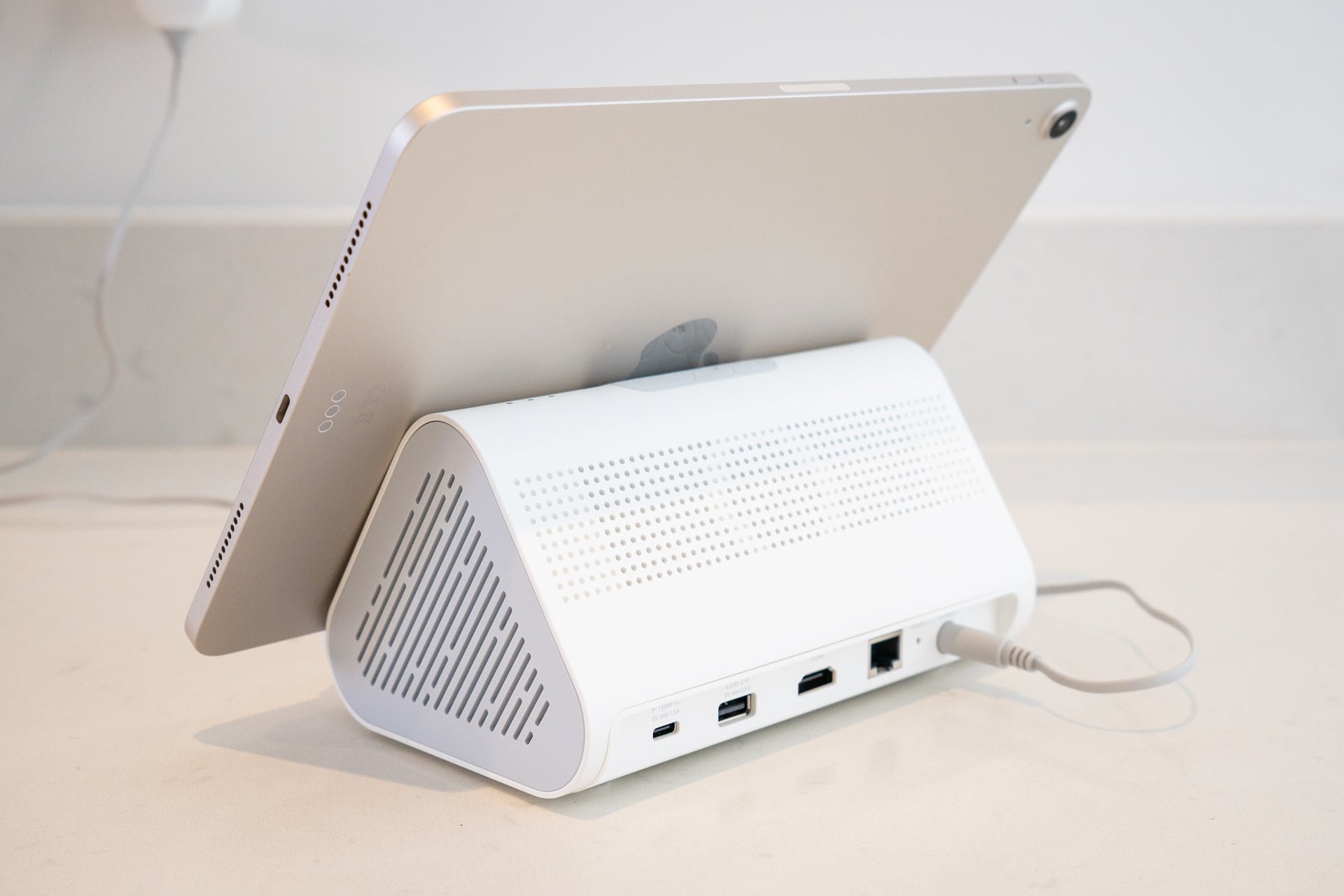
The H500 isn’t a security system on its own. But combine it with door/window sensors, motion detectors, a video doorbell and a couple of security cameras from the rest of the Tapo product family, and you soon have a fully-functioning, self-monitored home alarm system. The H500 can be configured to act as a siren, and there’s a microphone for use as an intercom with compatible doorbells and security cameras.
TP-Link doesn’t sell an external siren though, and there’s no keypad or support for RFID tags either, so you can’t arm and disarm the system in a conventional way as you enter and exit the property. Instead, the Tapo app lets you create automations, such as one that turns the cameras, door sensors and motion detector off when you are near home (based on the location of your smartphone). Alternatively, you can set a schedule for security devices, arming them at night and automatically disarming them each morning.
A key feature for smart home fans is Matter support. This means the H500 can connect to devices from other manufacturers – not just those made by TP-Link, but any smart home product or accessory that also supports the Matter connectivity standard.
Cameras
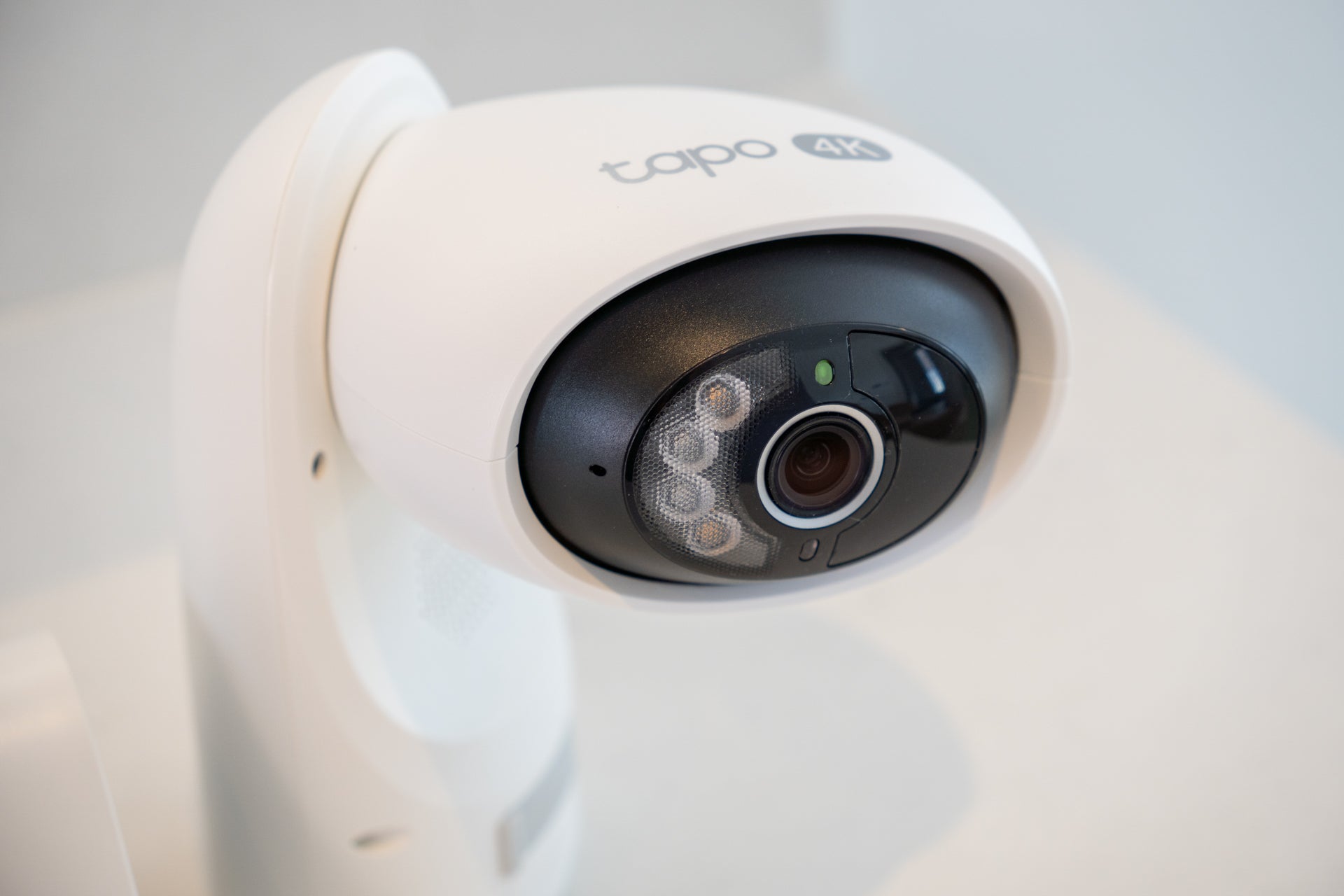
TP-Link sells a broad range of Tapo security cameras, for both indoor and outdoor use, and up to 16 can be added to the H500 hub. Many of these are wireless, battery-powered devices, with several coming with solar panels for a constant source of power. The latest Tapo cameras record in 4K resolution, with colour night vision and the option to store footage either on a microSD card (up to 512GB, not included), or on the H500 hub mentioned earlier, removing the need to subscribe to a cloud storage service.
TP-Link makes a point of its cameras having free person, pet and vehicle detection technology, since other systems, like Ring, bundle this feature into a monthly subscription service. Some Tapo cameras have a powered pan and tilt function, where they move to follow objects, such as a trespasser in your garden.
Tapo cameras are well priced, with the most affordable models costing under £60, while even the priciest 4K cameras with motion and a solar panel are under £200. Cameras with integrated spotlights are also available, and there are several Tapo video doorbells to choose from too.
Install the Tapo app on your tablet, and a live video feed can be viewed from up to four compatible cameras at once. You can then mount your tablet on the Tapo H500 hub, and turn an iPad into the heart of your home surveillance system.
Tapo cameras have a reputation for good value, and the latest models continue that trend. I tested the H500 hub with the company’s new C660 Kit, a wireless camera with motorised pan-and-tilt, 4K video, colour night vision and a solar panel for continuous power, which costs £180.
Monitoring

Unlike Simplisafe and Verisure, Tapo does not offer any form of professional monitoring. Instead, the Tapo app alerts you when the alarm is triggered, when your cameras spot something, and when a visitor presses the doorbell.
Some Tapo cameras – even wireless models powered by a solar panel – have a 24/7 recording function, where they can be sent to capture an image between every one and five seconds. This isn’t a replacement for professional monitoring, but it’s sure to give some buyers an extra level of protection when it comes to home surveillance.
Unlike Ring, there’s also no automated calling function with the Tapo system. If the alarm is triggered, you are notified via the app, but no phone call (even an automated one) is placed.
Subscription cost
Like Eufy, Tapo’s security system works fully without any form of subscription fee. Even the company’s suite of artificial intelligence functions – including facial recognition – is included for free, and all Tapo cameras can store footage to a microSD card or the H500 hub.
If you would rather have footage saved in the cloud, Tapo offers seven days of storage for £2.49 a month for one device, or 30 days of storage for £2.99. The latter increases to £5.49 for two devices, £7.99 for three devices, and £9.99 for 10 devices. Discounts are available if you commit to an annual subscription.
These are all optional. Instead, I would buy a large hard drive, slot that into the H500, and use that as a local storage hub for all of my Tapo cameras.
Deals and discounts
TP-Link has an online store that sells the full range of Tapo devices. There’s often a wide range of deals and discounts, including money off video doorbell, cameras and home security bundles. Current offers from the Tapo website and other retailers include:
Read the full TP-Link Tapo review
Buy now £159.99, Amazon
Yale Smart Alarm starter kit

Best: With an outdoor siren
Wifi: Yes, Ethernet optional
Cellular backup: Yes (subscription required)
Battery backup: Yes, 12 hours
Base station range: 1km (0.62 miles)
Sensor/accessory limit: 100
Base station dimensions: 17.5 x 17.5 x 3 cm
Outdoor siren: Yes
Professional monitoring: Yes, subscription required
Why we love it
- Outdoor siren included
- Optional professional monitoring
- Large wireless range
Take note
- Expensive
- Some poor hardware design
This alarm system offers a much-needed improvement over Yale’s aging (but still available) Sync alarm kits. The inclusion of two door/window sensors is welcome, as often kits only come with one, and so too is the external siren, which acts as both a visual and audible burglar deterrent.
I also like the Yale Home app, which works well with Yale’s latest range of security cameras, door locks and its video doorbell. Also appealing is how all of these products work as part of a cohesive system that requires no ongoing fee. In a world where rivals like Ring charge for access to basic functions, Yale’s alarm system works with no monthly or annual charge.
Setting up and using this alarm is nice and simple. The kit includes everything you need to wall-mount each accessory, and the hub can connect to your router either with wifi or the included Ethernet cable. Arming and disarming is done either with the keypad or with a tap of the Yale Home app.
Yale Home is also compatible with a broad range of voice assistants and smart home platforms, including Amazon Alexa, Google Home, Apple HomeKit, Philips Hue and SmartThings.
Cameras
Yale sells a broad range of security cameras, including traditional CCTV kits and cameras that form part of its smart home ecosystem. The latter comprises one mains powered indoor cameras and one battery powered outdoor camera.
Both use the same Yale Home smartphone app as the Yale Smart Alarm starter kit, and both record footage at 1080p Full HD resolution. They both have microphones and speakers for two-way communication, along with infrared night vision, AI-powered human detection, scheduling and customisable detection zones to help reduce false alarms.
Yale’s smart cameras record footage to a microSD card for free, or can save video to a cloud storage service available via a subscription plan.
Monitoring
Professional monitoring is available, but it’s more expensive than similar alternatives like Simplisafe. Yale’s monitoring service
Other subscriptions include cellular backup (where the hub connects to the mobile phone network if your wifi goes down), cellular backup, cloud storage for security camera recordings, and automated phone call alerts.
Subscription cost
Yale’s subscription services start at £5 per month for the Alarm plan, rising to £9 a month for Secure, which adds automated phone calls (like those offered by Ring) and cellular backup for your alarm system.
Professional monitoring akin to that of Simplisafe, with a manned, 24/7 emergency response system, costs £36 per month.
Deals and discounts
Yale’s security systems are among the more expensive, but that doesn’t mean there aren’t discounts to be found. The company’s online store frequently reduces prices by tens or even hundreds of pounds. You’ll find similar deals at other retailers too, including Amazon. The biggest discounts are usually applied to whole-home smart alarm kits and product bundles.
Read the full Yale Smart Alarm review
Buy now £379.05, Amazon
Yale Sync Alarm
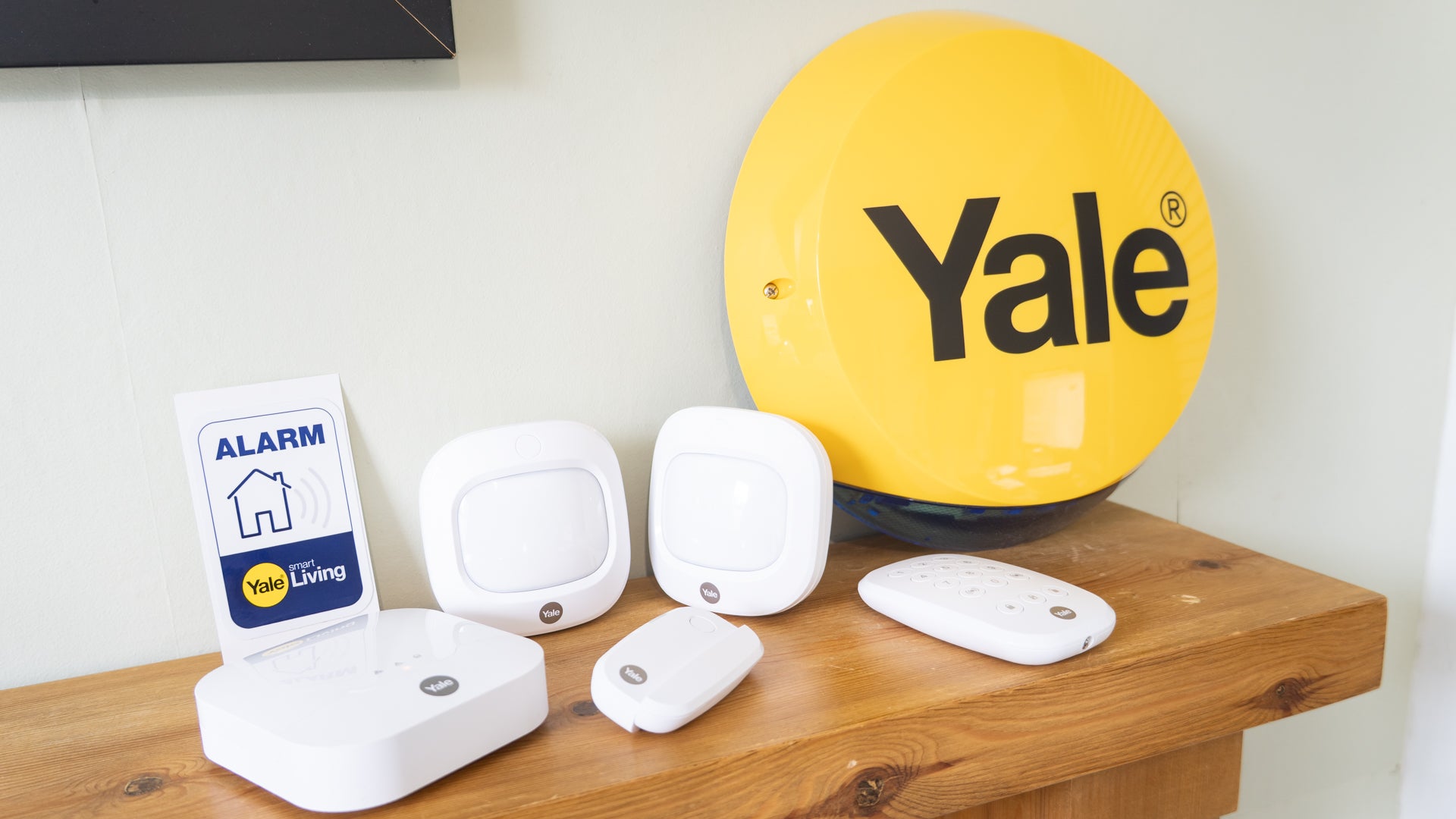
Best: For covering the basics
Wifi: No, Ethernet only
Cellular backup: No
Battery backup: Yes, up to 12 hours
Base station range: 200 metres
Sensor/accessory limit: 40
Base station dimensions: 9.5cm x 9.5cm x 2.5 cm
Outdoor siren: Yes
Professional monitoring: No
Why we love it
- Quality hardware
- Gets the basics right
- No subscription required
Take note
- Basic software
- Hub lacks wifi
- No professional monitoring
If you only need the basics, the Yale Sync is a solid option for your home. It doesn’t have the bells and whistles of other systems – and nor does it offer professional monitoring – but it includes a wireless outdoor siren that other systems lack. It also has a more compact base station than most, and the keypad is nice and small too.
Coming from a name synonymous with door locks and home security, the Yale Sync is a little more expensive than some rivals. But the inclusion of the siren helps make up for this, along with the lack of any costly subscription service. There’s support for Amazon Alexa and Philips Hue smart lighting, and the base station has a battery that can keep the alarm working for up to 12 hours during a powercut.
There‘s no cellular backup though, so you won’t receive a smartphone alert if your home internet is down when the alarm is triggered, and the base station doesn’t have Wi-Fi. This means it needs to be plugged into your router with an Ethernet cable, which limits where you can locate it.

Yale sells extra accessories like motion detectors and door/window sensors, letting you build up a larger system than what’s included in the kit. The base station works with up to 40 devices at a distance of up to 200 metres, giving you the option to secure an outbuilding like a shed or garage as well as your house.
I liked how the outdoor siren and door/window sensors come with tamper sensors, which send an alert to the app if they are removed from wherever they are mounted.
This system is a little older than Yale’s latest Smart alarm system, which uses the equally new Yale Home app. Instead, the Sync kit featured here uses the older Yale Alarm app, which is starting to show its age with limited functionality and a sense that it is no longer being developed. Although more expensive, the newer kits also have the option to subscribe to professional monitoring by Securitas.
Cameras
As well as its range of smart cameras mentioned earlier, Yale also sells standalone indoor and outdoor security cameras. Some models feature floodlights and sirens to act as an intruder deterrent, while others offer motorised panning and tilting to capture a full view of their environment.
Yale’s more conventional home CCTV kits can be bought with two or four cameras and offer wired or wireless installation.
Monitoring
A simpler system than the Yale Smart alarm featured above, Yale’s Sync kit does not offer monitoring. As such, this is a system that you monitor and control entirely yourself.
Subscription cost
There are no subscriptions available for Yale Sync.
Deals and discounts
As with the Yale Smart system above, there are some deals to be found on Yale’s own website, and at retailers like Amazon too.
Read the full Yale Sync review
Buy now £236.98, Yalehome.co.uk
Smart home security FAQs
How do smart home security systems work?
Unlike traditional alarm systems, smart home security kits are wireless and connect to your smartphone via an internet connection. Such kits usually consist of a base station which connects to your router, either with wifi or an Ethernet cable, then connects to dozens of wireless accessories like motion detectors, door/window sensors, sirens, keypads, cameras and more.
Most kits also come with a wireless keypad for arming and disarming the alarm, although this can also be done via a smartphone app and, often, by speaking to a voice assistant like Amazon Alexa or Google Assistant. Some systems can be configured to turn on and off based on the location of your smartphone, and that of anyone you live with.
When triggered by a break-in or movement, these alarms alert you via the smartphone app. Some also make an automated phone call to your or whoever is on your emergency contacts list. Some systems offer professional monitoring for a monthly fee, where service agents respond to your alarm, use the cameras (with your prior permission) to see what’s going on, and even call the emergency services if required.
Should I install it myself or get professional help?
In practically every case, smart home alarm systems can be installed without professional help. Most simply connect to your router, then use wireless technology and battery power to function, leaving you to fit the various sensors and detectors to your walls, doors and windows either with the included screws or adhesive pads.
Some external devices, like sirens and security cameras, might require a ladder and a power drill to mount them onto an outside wall. But that’s about as difficult as these installations get. Once installed, the systems are usually set up and configured via a smartphone app.
Are home security systems worth the money?
It’s hard to put a price on securing your home against burglars. Hardware costs are generally quite similar between brands, although naturally the larger the system, the more devices included and therefore the more you’ll have to pay.
What’s arguably more important is the cost of an ongoing subscription. Most smart alarm systems offer extra features via a monthly or annual subscription, including cloud storage for video camera recordings and enhanced functionality. Professional monitoring also comes as part of a subscription, but few alarm systems offer this service in the UK.
For example, Ring Alarm and Eufy Home Alarm both offer professional monitoring (for a fee) in the US, but they don’t offer it in the UK. If you want professional monitoring in the UK, Simplisafe is one of your best options and, for us, the best home security system in 2025.
What are the key features to look out for?
Almost all systems get the basics right by including a base station, motion detectors, door/window sensors, a keypad for arming and disarming, and a smartphone app.
Beyond that, features to look out for are battery and cellular backup systems for the base station; with those, it will keep working for a limited time (usually 12 to 24 hours), even if your internet goes off and there’s a power cut.
Another useful feature is smart home connectivity. If you already have some smart home devices, like security cameras or a video doorbell, it might be worth buying an alarm system from the same ecosystem, like Eufy, or which works with the same smart home platform, like Alexa or Apple HomeKit.
The biggest optional extra is professional monitoring, which sees an agent remotely check your home when the alarm is triggered and even call the emergency services on your behalf.
Do home security systems require a subscription?
Many home security and house alarm systems offer a subscription for unlocking full functionality. In most cases, paying a monthly or annual fee enables cloud storage, where recordings from security cameras and video doorbells are uploaded and saved in the cloud. They can then be viewed and downloaded via the security system’s smartphone app. Paying for cloud storage is practically a necessity for some systems, such as Ring, since its products do not store recordings locally.
Other features unlocked by paying for a subscription include AI-powered person detection, cellular backup for keeping your alarm system online during a broadband outage, and discounts on future purchases.
But the biggest reason for a paid subscription is professional monitoring. As outlined in the previous section, this is where a human will respond to your alarm whenever it is triggered, check in to see what’s caused it, and even call the emergency services if deemed necessary – all without you doing anything. Simplisafe and Verisure both offer professional monitoring subscriptions in the UK. Ring offers such a service in the US, but not in the UK; instead, Ring’s subscription here is limited to cloud storage and a few extra features, like cellular backup.
Some companies, such as Eufy, offer security systems that work without a subscription. These cameras and doorbells store footage locally, and the alarm system doesn’t hide any features behind a paywall. Eufy does offer a cloud storage subscription, but this is entirely optional.
Do home security systems affect home insurance?
This will depend on your specific circumstances, but it’s definitely worth telling your insurer when you've fitted a security system. That said, not every insurance provider will automatically reduce your premium, and some will ask that a certain type of system is fitted before considering any changes. It’s worth checking with your insurance provider first, since they might only agree to a reduced premium if you fit a certain brand or type of system. A professionally monitored system, like those from Simplisafe and Verisure, are more likely to result in a discount than simpler, self-monitored systems. But it’s worth checking to be sure.
In any case, there were over 250,000 residential and non-residential burglaries in the UK in 2024, according to the Office for National Statistics. And, while that was down six per cent on the previous – and down a massive 71 per cent on 2003, when current record-taking began – it still means hundreds of properties are being broken into every day.
So regardless of whether an alarm system lowers your insurance premium, the peace of mind it brings could be worth it alone.
The verdict: Best smart home security system
Simplisafe is currently my favourite smart home security system. It is very easy to set up and install, and there’s a wide range of optional extras to build a whole-home system. But what helps this house alarm stand out from its rivals is the option to pay £27.99 a month for professional monitoring. Since Ring and Eufy don’t offer this service in the UK, it’s something that puts Simplisafe at the top of our list. The Yale Smart Alarm also offers full, 24/7 professional monitoring, but at a higher monthly cost of £36 per month.
If you don’t need professional monitoring, then check out Rin Alarm and the Eufy Home Alarm Kit. Both offer excellent alarm kits that connect to their wider smart home systems comprising security cameras, video doorbells and more. I especially like how Eufy records footage locally, thus avoiding the cloud storage fees imposed by Ring.
Finally, if you want to build a large smart home system, I recommend TP-Link Tapo, since the H500 hub has Matter support that makes it compatible with a huge number of smart home devices and accessories, beyond just security products.

